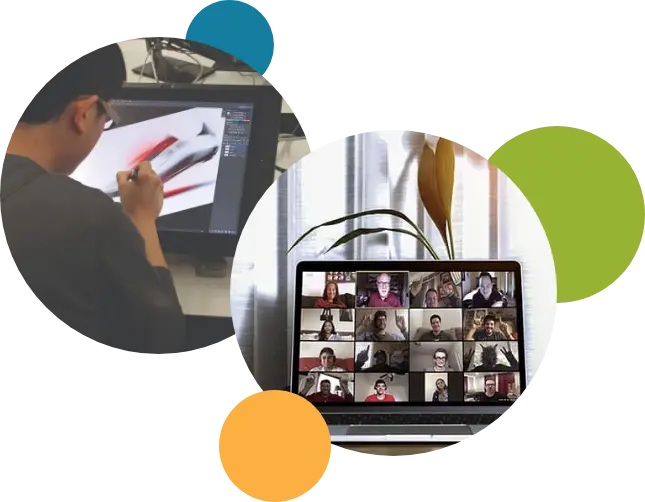
Online Learning Options
Academy of Art University has the expertise to provide our students with accredited art and design degrees in three ways: traditional online courses (asynchronous learning), virtual onsite courses (synchronous learning), and on-campus courses in San Francisco.
As an early pioneer in online learning, the Academy has always designed our online programs to offer the same quality of education our on-campus students enjoy. Studying with us online, however, offers you greater flexibility; you can study from anywhere in the world, on your schedule.


Traditional Online vs. Virtual Onsite Courses
For those who are new to online learning, it’s important to know that there are two main approaches to learning online—traditional online and virtual onsite courses. Depending on what kind of learner you are, the differences between these two approaches can have an impact on your success. Once you have a clear sense of what differentiates these two approaches, you’ll be better prepared to choose between the two, and pick an online approach that fits you best.
Traditional Online Courses
Traditional online courses (asynchronous learning) are experienced virtually through online channels, without real-time interaction with your instructors and classmates. Asynchronous learning is all about flexibility; You can do your coursework whenever you choose, depending on your schedule.
At Academy of Art University, asynchronous courses are a mix of video lecture content, written content, recorded audio, interactive slideshows, virtual libraries, exchanges across discussion boards or social media platforms, and hands-on work. Asynchronous students still get one-on-one feedback from their instructors and classmates. Students can record video and audio to accompany photos or written descriptions of artwork submitted for evaluation. Instructors then provide detailed feedback by providing commentary in written, visual, and audio formats. Each course also offers a class discussion area where students and instructors can communicate freely, post work, and provide/receive feedback. This gives you and your peers a sense of community.
Ideal for:
- Students who are juggling work and family commitments, and don’t always have time to log in at a certain hour. Students set their own schedules and can pace their learning.
- Students who don’t like to be rushed or put on the spot. Thoughtful, introverted students have time to formulate answers and responses.


Virtual Onsite Courses
Virtual onsite courses (synchronous learning) happen in real time, but remotely. You attend class at a specific time, which allows you, your classmates, and your instructor to interact in a specific virtual place, through a specific online medium such as Zoom. In most cases, you can see the instructor, and your instructor can see you.
Ideal for:
- Students who feel more comfortable speaking in class, and who value a live classroom environment.
- Students who like to have a level of social intimacy and develop a real personal relationship with the faculty and other students.
Next Steps
For more information, sign up for an online Open House or Online Education Webinar. You will learn how our online curricula are designed, how hands-on projects work in the online environment, and how to be successful as an online student at the Academy.
REQUEST INFO